A Year’s Journey in 50 Shuls
To make a pilgrimage is to travel far and participate in something holy, singular and transformative. On the death of a parent Jews make a pilgrimage thrice daily to a synagogue to participate in the same ritual, the kaddish said over and over. It doesn’t have to be far or near. It simply must be a place that Jews have decided is holy. And if we open our hearts, it is always transformative. That is what Max Miller discovered and documented in the year he said kaddish for his father. Final Mourner’s Kaddish: 333 Days in Paintings by Max Miller currently at Yeshiva University Museum until August 16, 2009 is more than the 50 brilliant watercolors of the shuls that Miller visited to say kaddish. Every painting is accompanied by a textual comment on each synagogue, a personal mediation on what happened there that day and what impression this place of Jewish holiness made upon him. With this text in hand, which is the only way this exhibition should be seen, suddenly a random selection of images becomes a hymn to American Judaism, a celebration of its diversity, complexity and most of all its warmth and kindness.
The geography of Miller’s synagogue pilgrimage was diverse; his journeys from New York, Brooklyn, Miami, Coral Gables, Florida; Burlington, Addison County, & Middlebury, Vermont; Columbus & Bexely, Ohio and finally Baltimore, Maryland, were driven by the vicissitudes of earning a living and familial obligations. By memorializing a watercolor image of the shul in which he said kaddish he made each trip precious, effectively creating a pilgrimage site. The visual diversity is truly amazing, constantly shifting his focus from details of an aron, the paroches, a glorious ceiling stained glass window, a modernist façade to the jumble of men davening, a view from the pews to a view of an entire interior. Each image is different, unique and, once seen in the context of the text, amazingly personal.
The artist, along with curator Reba Wulkin, has meticulously grouped his shuls to create mini-narratives that highlight the contrasts between communities and his experience of them. An excellent example is the coupling of the Bialystoker Shul on the Lower East Side, a busy bright image of the ornate aron, contrasted with a plain image of the simple wooden aron set in the corner of the Hillel in Middlebury College in Vermont. The Bialystoker recalled for Miller his maternal grandparents who lived on the Lower East Side a hundred years ago. Saying kaddish there immersed him in the religious and traditional world of his ancestors. In a contrast both visual and emotional, the Hillel aron in Vermont exposed him to a younger generation who embodied tradition by the conscientiousness of the students and Rabbi Ira Schiffer making sure he had a minyan during his teaching stint at the college. “The students were right on it, helpful. I was thrilled, impressed, and amazed.”
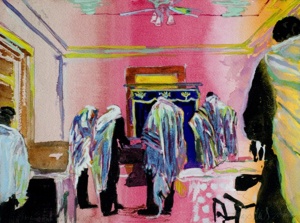
Miller, evidently not a frequent shul-goer in the past, was abruptly thrust into a complex and diverse world when he took on the responsibility of saying kaddish for his father. But the experience quickly became a source of constant surprise and comfort. He relates that in the Chabad in Burlington, Vermont he is immediately welcomed and given a cup of tea, especially welcome since it was twenty degrees below zero at the time. And of course, Kiddush and lunch are offered. Similarly at the Biyanah Shul on the Lower East Side he is hugged and greeted warmly on a Shabbos morning. His reaction is grateful, “In the past, this would have seemed to be a community from which I was worlds apart.” Now he is welcomed as a friend.
In his wanderings he discovers many things. First in some shuls he stumbles upon unexpected connections; a friend of his parents helped found one, a student tells him she had her Bat Mitzvah in another, and still others uncover surprising links to a whole host of family and friends. The Jewish universe starts to seem more intimate.
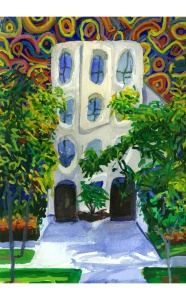
And funny. He walks into a synagogue in Miami Beach. At first there are only two people there. “More come in. Someone comes up to me and says, ‘Excuse me, you are sitting in my seat, would you mind moving?’ Someone else comes up to me and I say ‘Hello.’ He says, ‘Excuse me, you are sitting in my seat….” After a few more encounters… “At this point I’m pretty flattered as everyone is speaking to me. I move 15 times for 12 people (some of them ask me twice.)” Jewish musical chairs plays on.
It is the poignancy and familiarity of these stories that transform his lively watercolors from a visual feast to a rich banquet of Jewish experience. One can see the subtleties of these experiences in many of his images. Chabad, Burlington, Vermont sports psychedelic color, both in the walls and in many of the tallism of the daveners, alluding to the fervent spirituality of Lubavitch Chasidim and those drawn to them. And yet there is a figure on the extreme left in a plain light-colored jacket without any tallis at all. Is that perhaps Miller, still feeling a bit apart from the minyan even as he is embraced by the color and structure of the shul, not to mention the cup of tea?
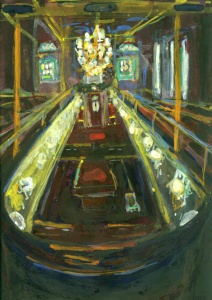
Frequently Miller evokes his memory of the shul with the use of light as a metaphor for warmth and welcomeness. Charles Street views the sanctuary from the vantage point of the women’s balcony, the lights casting an eerie glow on the supporting poles and ceiling above. The chandelier seems to float suspended like an internal moon, further illuminating the reader’s desk and distant aron. On Shabbos Miller was welcomed by “Herman, who is in charge…” and went back to sample Andy Statman’s klezmer music later in the week. One could imagine the shimmering lights as visual echoes of the soulful music played there over the years.
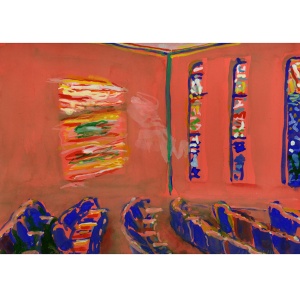
In an early watercolor Miller depicts Agudas Achim in Columbus, Ohio. Soon after his father’s death it was one of the first shuls he said kaddish in while visiting his mother in Columbus. It is a stark, arresting image; the rows of comfortable blue seats in profile contrasted with the walls pierced by brilliant stained glass windows. On an intense coral-colored wall an object floats, perhaps another stained glass window, perhaps a large wall hanging. It is a disturbing presence, almost a tinted ghost, that reflects his uneasy state and, as he discovers later, a shul riven with controversy, about to change from an orthodox to a conservative synagogue. Its uneasy change seems to reflect his own turmoil in mourning.
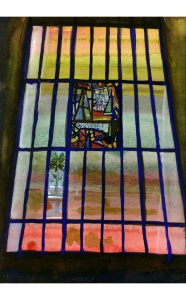
The pilgrimage is one in which the seeker doesn’t know either where he is going or what he will find. And yet for a year, he continues. Miller finds himself in Temple Judea in Coral Gables, Florida. He was entranced by the blue stained glass behind the bimah and was informed it was from the original Morris Lapidus design. Suddenly he remembers his father, an architect, admired Lapidus; “He would have loved Temple Judea.” The pilgrim has found, quite by accident, that which he seeks, a connection and a memory of his father. And yet his image of it is quite different, a single panel of abstracted glass locked in a grid of translucent glass. And yet one clear pane looks out on the palm trees outside, a perfect vignette of the inside / outside conundrum the mourner is forced to traverse.
All fifty of Miller’s watercolors are part of one complete and complex work of art. It is an homage to a year spent in transformation, in art a memorial to his departed father, celebrated through a son’s creativity. He started as an outsider and has now made us all insiders. Max Miller has accomplished something quite moving for us in his pilgrimage. He has shown us the breath and depth of American Jewry in the multitude of shuls he visited. His year of mourning and saying kaddish could only have been done with his fellow Jews in their sacred spaces, each different and yet sharing a bond of holiness. The ultimate unity of the Jewish people is found in these remarkable works.
Final Mourner’s Kaddish: 333 Days in Paintings by Max Miller
Yeshiva University Museum – Center for Jewish History
15 West 16th Street, New York, N.Y.
Exhibition Sponsor: New York Foundation for the Arts
www.yumuseum.org